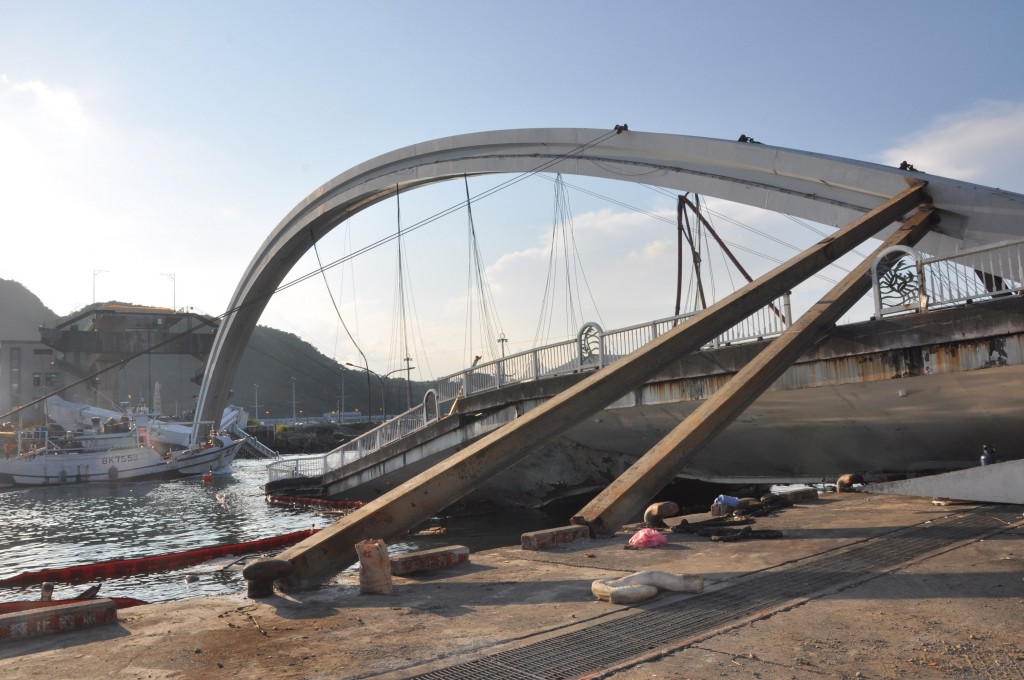
Earlier this month, an arch bridge over the eastern Taiwan bay collapsed, injuring over twenty people and killing six people. The tragic event raises questions on why the Nanfang'ao bridge had collapsed. While the official investigation has yet to conclude, few theories are floating around.
The 'new' Nanfang'ao bridge was a single-span steel tied-arch bridge spanning 460 feet. It was opened to the public in 1998, replacing the former bridge, just celebrated its 20th anniversary.
Steel Tied-Arch bridges have three significant elements to them: the arch rib, the cables or hangers, and the tie. The system is quite simple - when a load is being applied to the deck, it's carried up the hangers and through the arch, balanced by the tension in the tie. Because the arch is only held longitudinally at one end, when the arch deflects down from the thrust, the other end is free and expand or contract. It's really just a simply supported beam
Typically if considering the effects of a loss of one hanger, the downward collapse of the tie and deck is not likely; the failure of the arch is the more significant concern. It's because the tie can transfer the load to the remaining hangers. However, the hanger spacing and offset can increase exponentially, causing the arch to buckle. With the Nanfang'ao bridge, most of the hangers have snapped while the arch remained intact even after impact with the water. So what did cause the failure of the Nanfang'ao bridge?

Experts have weighed in and speculated a few hypotheses:
1) Long-term vibrations to the hanger anchors resulting in fatigue and causing the anchors to weaken and fail. The anchors reached a tipping point by an onslaught by Typhoon Mitag from a few hours earlier.
2) A 3.8 magnitude earthquake earlier that morning had compromised the integrity of the bridge pier, causing the deck to buckle under the bridge weight and additional weight.
3) Corrosion in the hangers caused by environmental exposure such as saltwater and air was keeping the hangers at the limits of their load-bearing capacity.
While each theory focuses on the cause of the collapse, the prevention is what needs precedence. The number one method of prevention is rigorous monitoring and maintenance. While many of the theories above may aggravate the conditions of the bridge, a well-maintained structure is engineered to withstand natural and environmental risks.
Historically bridges usually failed during construction, but recently, we see more structures failing due to poor maintenance. The Polcevera viaduct in Genoa, Italy, is a perfect example. This tragic and preventable accident, which resulted in 43 causalities in August 2018, was found due to poor maintenance and corrosion in the suspension cables.
Troubling revelations from maintenance consultants observed the same with the Nanfang'ao bridge; significant signs of rust and damaged connections were found at the anchors and tie. Taiwanese President Tsai Ing-wen issued an investigation of all bridges in Taiwan following this tragedy.
Midas Civil's bridge analysis and design technology are used by reviewers and designers alike to simulate the maintenance and rehabilitation of signature structures such as the New Bayonne Bridge (NJ), a 5,322-foot steel arch bridge. Initial proposals included a new cable-stayed bridge or tunnel to increase air draft. An unprecedented option was chosen to raise the structure 64-feet. CIVIL was used to complete the staged construction analysis to determine the feasibility and design. The endeavor saved the Port Authority of New York and New Jersey, $450 million, and three years of construction time. For more information, click here >.
Software: Midas CIVIL.
Press, The Associated. “Taiwan Bridge Collapses over Waterway.” The New York Times, The New York Times, 1 Oct. 2019, https://www.nytimes.com/video/world/100000006746147/taiwan-bridge-video.html?src=vidm.
Don't you worry! We've got you a trial license.

Or get a license for $600/month!

Copyright 2020 - 2025. Midasoft. All Rights Reserved.
Support
Technical Support
Downloads
Add a Comment